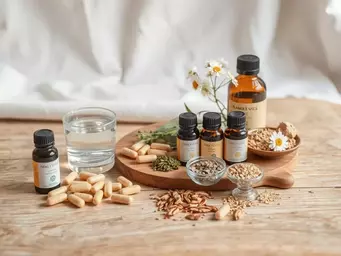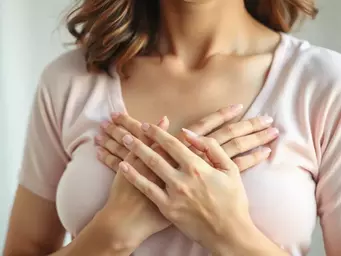Choosing a Bra for Tenderness Relief

Breast tenderness affects many women and can be linked to various stages of life. Understanding its causes can empower you to manage this discomfort effectively. Have you considered how a few simple changes can enhance your overall comfort and well-being?
What You Will Learn
- Breast tenderness, or mastalgia, is often linked to hormonal changes, especially during the menstrual cycle, pregnancy, and menopause.
- Lifestyle factors such as diet, stress, and exercise can significantly impact breast sensitivity.
- Identifying the causes of your breast tenderness can help you make informed choices about your health and comfort.
- Wearing a supportive bra can alleviate discomfort and improve your posture, benefiting your overall breast health.
- Taking proactive steps, such as measuring for the right bra fit and consulting with professionals, can enhance your breast health journey.
Understanding Key Influencers of Breast Tenderness
Hormonal changes, lifestyle choices, and proper support significantly impact breast comfort. Explore the primary causes and effective solutions below.
Hormonal Changes: Primary Cause
- PMS: Estrogen surge before period.
- Pregnancy: High hormone levels for baby.
- Menopause: Fluctuating hormone levels.
Lifestyle & Diet
- High Caffeine: May increase swelling.
- High Salt: Contributes to fluid retention.
- Stress: Can exacerbate discomfort.
Bra Support & Fit
- Correct Fit: Prevents physical discomfort.
- Breathable Material: Softness on skin.
- Adjustability: Tailored support.
Understanding Breast Tenderness and Its Causes
Have you ever experienced that uncomfortable, aching feeling in your breasts? You’re not alone! Breast tenderness is a common issue many women face, often reflecting various changes in the body. At Breast Tenderness, we aim to help you understand this phenomenon better, empowering you with knowledge about its causes and how to manage it effectively.
Breast tenderness, also known as mastalgia, can manifest as a dull ache, sharp pain, or even a feeling of swelling. It's essential to recognize that while this discomfort can be alarming, it is mostly a normal part of many women’s lives. In fact, understanding the underlying causes can help you identify when it’s time to seek professional advice or when you can manage it with simple lifestyle adjustments.

What Is Breast Tenderness?
Breast tenderness refers to the sensitivity or pain experienced in the breast tissue. This can range from mild discomfort to severe pain that impacts daily activities. Many women notice this tenderness as they go through different life stages, particularly during their menstrual cycles, pregnancy, or even while nursing. It’s vital to listen to your body and recognize what is typical for you!
- Menstrual Cycle: Hormonal fluctuations during your cycle can lead to cyclic breast tenderness.
- Pregnancy: Hormones surge, preparing the body for breastfeeding, leading to increased sensitivity.
- Lifestyle Factors: Stress, diet, and exercise can also influence how your breasts feel.
Tracking when tenderness occurs can help you understand your body’s rhythm better. Have you considered keeping a journal? This simple habit can reveal patterns that might be affecting your comfort level!
Common Causes of Breast Tenderness
Understanding the common causes of breast tenderness can help demystify the experience. Here are some of the most prevalent reasons:
- Hormonal Changes: Fluctuations in hormones, particularly estrogen and progesterone, are often at the root of tenderness.
- Medications: Some medications, including hormonal treatments, can cause side effects like breast sensitivity.
- Diet: High caffeine and salt intake might contribute to swelling and discomfort.
- Ill-fitting Bras: Wearing the wrong size can lead to physical discomfort that translates to tenderness.
By identifying these causes, you can begin to address them effectively. For instance, evaluating your dietary habits or reassessing your bra size can lead to significant improvements!
The Impact of Hormonal Changes on Breast Tenderness
Hormones play a crucial role in breast tenderness. During particular times of your menstrual cycle, these hormone levels fluctuate dramatically, often causing the breasts to feel tender or swollen. For example, right before your period, estrogen levels rise, which can lead to increased sensitivity.
- PMS: Many women notice tenderness as part of premenstrual syndrome.
- Pregnancy: A surge in hormones prepares the body for the baby, leading to sensitivity.
- Menopause: As hormone levels change during menopause, tenderness may also fluctuate.
Recognizing how these hormonal shifts relate to your breast health is vital. Keeping track of your symptoms can help you understand when to expect tenderness, providing you with a sense of control.
We Want to Hear From You!
Have you ever tracked your breast tenderness? If so, what patterns have you noticed? Share your experiences and insights with us below:
Frequently Asked Questions About Breast Tenderness
- Q: What is breast tenderness (mastalgia)?
- A: Breast tenderness, or mastalgia, is sensitivity or pain experienced in the breast tissue, ranging from mild discomfort to severe pain. It is a common issue linked to various life stages and hormonal changes.
- Q: What are the main causes of breast tenderness?
- A: The main causes include hormonal fluctuations (especially during menstrual cycles, pregnancy, and menopause), certain medications, dietary factors (like high caffeine and salt intake), and wearing ill-fitting bras.
- Q: How do hormones affect breast tenderness?
- A: Hormonal changes, particularly fluctuations in estrogen and progesterone, play a crucial role. Increased estrogen before a period, the surge of hormones during pregnancy, and shifting levels during menopause can all lead to breast sensitivity and swelling.
- Q: Can lifestyle choices impact breast tenderness?
- A: Yes, lifestyle factors such as diet (high caffeine and salt intake), stress, and exercise can significantly influence how your breasts feel and can exacerbate discomfort.
- Q: How can a supportive bra help with breast tenderness?
- A: A well-fitted, supportive bra can alleviate physical discomfort, improve posture, reduce pain linked to hormonal changes and activity, and enhance circulation, contributing to overall breast health.
- Q: What features should I look for in a supportive bra?
- A: Key features include a correct fit that is snug but comfortable, breathable materials, a style that suits your activity level (wireless or underwire), and adjustable straps and bands for tailored support. Research from the University of Central Lancashire highlights the importance of proper bra support for overall breast health, suggesting that a well-fitted bra can significantly reduce discomfort and improve daily comfort.
- Q: Where can I find guidance on choosing the right bra size?
- A: You can use online size guides, visit specialty lingerie stores for professional fittings, consult expert blogs, or watch videos and tutorials. Organizations like Breast Cancer Now offer valuable resources to help women find a well-fitting bra that provides optimal support and comfort.
Summary of Key Takeaways for Choosing the Right Supportive Bra
When it comes to alleviating breast tenderness, selecting the right supportive bra is essential. It’s not just about style; the features of a supportive bra can greatly impact your comfort level and overall breast health. Here are some key features to consider:
- Fit: A well-fitted bra should provide support without causing discomfort.
- Material: Look for breathable fabrics that offer softness against your skin.
- Style: Choose between wireless and underwire based on your activity level and personal preference.
- Adjustability: Straps and bands should be adjustable to ensure a tailored fit.
Remember, investing in a supportive bra is an investment in your health. The long-term benefits of proper bra support can include reduced breast tenderness and improved posture. It’s a small change that can lead to significant comfort during your daily activities!

Recap of Important Features to Consider
In summary, here’s a quick recap of the important features you should keep in mind when choosing a supportive bra:
- Ensure it fits snugly but comfortably around your ribcage.
- Choose materials that are both supportive and gentle on your skin.
- Consider your lifestyle: are you more active or do you prefer leisure wear?
- Look for bras with adjustable straps for personalized support.
Having the right bra can make a world of difference. It can enhance your confidence and help you feel more at ease in your body. At Breast Tenderness, we believe that informed choices lead to better health outcomes!
The Long-Term Benefits of Proper Bra Support for Breast Health
Wearing a supportive bra isn't just about comfort in the moment; it has long-term implications for your breast health. Some benefits of proper bra support include:
- Reduced Pain: A supportive bra can alleviate discomfort linked to hormonal changes and physical activity.
- Improved Posture: Good support helps maintain proper alignment, which can prevent back and neck strain.
- Enhanced Circulation: The right fit promotes blood flow, which is essential for overall breast health.
By choosing the right supportive bras, you’re investing in not just comfort but also in your long-term breast health. So, don’t underestimate the value of proper support!
Encouragement to Take Action
Next Steps for Finding Your Ideal Supportive Bra
Ready to find your perfect supportive bra? Start by assessing your current wardrobe. Are there bras that simply don’t fit right or provide the support you need? It might be time for a change! Here are the next steps you can take:
- Measure Yourself: Take accurate measurements to ensure you know your size.
- Visit Specialty Stores: Engage with experts who can help guide you in making the right choice.
- Try Before You Buy: Don’t hesitate to try on various styles to find the one that feels best.
Taking these steps can lead to a more empowered shopping experience and ultimately to greater comfort. You deserve it!
Resources for Further Assistance and Buying Guidance
For those who want additional help, there are a plethora of resources available. Consider looking into:
- Online Size Guides: Many brands provide comprehensive size charts to assist in finding your fit.
- Expert Blogs: Follow my posts on Breast Tenderness for tips on selecting bras tailored to your needs.
- Videos and Tutorials: Visual guides can demonstrate how to measure yourself effectively.
These resources can simplify the process and empower you to make informed choices about your breast health!
Consulting with Specialists for Personalized Advice
Sometimes, the best course of action is to seek a professional opinion. Consulting with specialists can provide you with tailored advice. Here’s how you can approach this:
- Speak with a Fitter: Visit a local lingerie store and ask for a professional fitting.
- Consult a Healthcare Provider: If you experience persistent discomfort, a discussion with your doctor can reveal underlying issues.
- Join Support Groups: Engage with communities focused on breast health for shared experiences and recommendations.
Taking action for your breast health is essential. By consulting experts and utilizing available resources, you can navigate the journey towards finding the ideal supportive bra with confidence!
Recap of Key Points
Here is a quick recap of the important points discussed in the article:
- Breast tenderness is a common issue linked to hormonal changes, menstrual cycles, and lifestyle factors.
- Tracking symptoms can help you understand your body’s rhythms and identify triggers for tenderness.
- Choosing the right supportive bra is crucial; consider fit, material, style, and adjustability for optimal comfort.
- Consulting with professionals can provide personalized advice and recommendations for managing breast tenderness effectively.







